|
Steele’n
TIME
Restoration of Fire-Damaged
Beneteau Oceanis 390 in
Sault Ste. Marie, Ontario
By David Steele
During my time on the Internet I was able to track
down the original owner of the boat through the boat
title records in Ohio. I discovered that a person in
North Carolina originally owned the boat before it
was brought to Ohio. Amazingly I was able to track
down the original owner’s address and telephone
number in a matter of minutes. I eventually spoke
with the original owner to gain additional info on
the boats history. I was able to gain valuable
information regarding the condition of the motor and
amount of use the boat had seen in the past. He
explained that the boat had only been used for about
3 years before being struck by lightning at his dock
in 1999 and that this was the cause of the fire, not
vandalism as the seller had told me. This lack of
use explained why the hull was in such good
condition but also gave me particular concern
because now I was also looking at possibly replacing
many if not all of the electrical components and
wiring, something that could and would add
considerable time and cost.
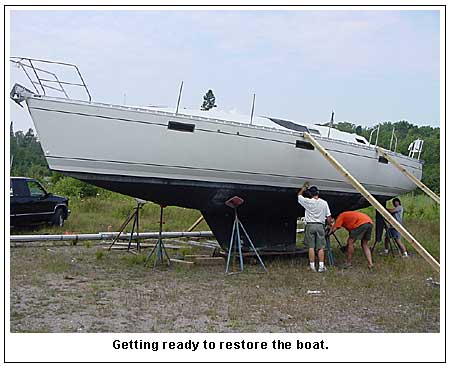 |
We had made arrangements to have
the boat delivered to a nearby marina located about
2 miles from our home called Gitchee Gummee Marina
in Havilland Bay. When the boat finally arrived in
mid August the first order of business was to
enclose it with some sort of temporary structure to
prevent any further water damage, this would also
serve as indoor storage because in Canada it seems
like winter can start anytime after Labour Day. An
old steel greenhouse frame was used to cover the
entire vessel from bow to stern. This was then
covered by an 60 x 40 tarp. The inside of the
structure was illuminated with construction lights
powered by a generator while we were working.
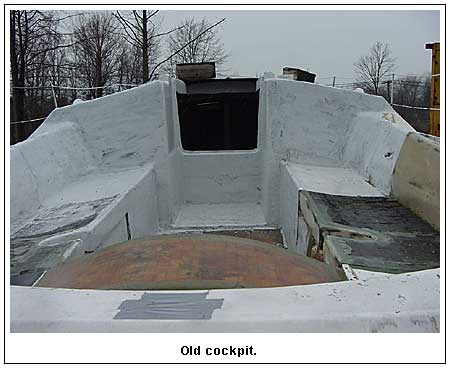
After enclosing the boat from the weather we had
more time to survey the damage and remove parts that
were too badly damaged to be repaired, which turned
out to be most of them. A “To Do” list was prepared
that would include items that had to be repaired or
replaced in order to restore the boat to minimum
operating condition, a second “Wish List” was
prepared to which would be the items we would like
to have on the boat in order to make it more
comfortable cruising on when complete, these were
also the items that could be easily deleted if costs
began to become prohibitive. After reviewing the
lists we estimated an amount of time that it would
take to complete each one, this was probably our
first mistake as we learned later that everything on
a boat takes twice as long to repair and costs twice
as much. Perhaps we were forgetting something but
when we added the numbers up it looked like it was
possible to have the boat easily completed in about
8 months working part time at it. Could this be
possible?? Shouldn’t be a problem, I built my house
in 9 months. Once again an adrenaline rush over took
me and I started telling some friends that I might
have this boat in the water by next spring. This
might have been my second mistake because I think
they all realized how much work was involved and
knew they would have to help in order to make this
new deadline. Discussing this new time frame with
the wife was another story. I thought this was
supposed to be a five year project? Why do we need
to get it completed so fast? When will you find the
time? And how do you plan on paying for it? These
were a few of the questions she asked, some of the
others cannot be printed! With surprisingly little
convincing she agreed that we would put most things
on hold and try to complete the boat for next
spring, I was starting to see that she was just as
excited about this as I was.
We only had about 2 months to
complete the work required to seal the boat from the
elements and do any work that was temperature
sensitive as winter was quickly approaching. During
this period my daily routine was to generally come
home from my regular job and start another 8 hour
shift inside some cramped area within the boat,
weekends would involve many 16 hour days. Loretta
and the kids would bring supper over to me and would
usually try and clean some additional areas of the
boat as the smoke had penetrated every nook and
cranny, it was their way of saying I miss you! Over
time the boat even started to feel like home, it is
truly amazing that when you are immersed in a
project like this that you become totally enveloped
by it, you actually become addicted to it; truly
eat, sleep and breathing it. We are not sure if this
was good, bad, or normal.
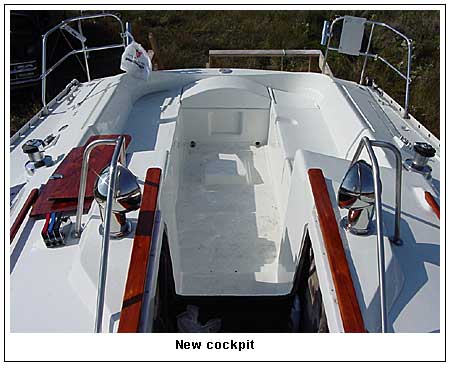 |
During this time we were able to
basically remove the complete interior of the boat
and reinstalled only the pieces that were not
damaged, millwork that was to be repaired or
replaced was taken to my heated garage where I have
a fairly decent array of woodworking tools. Keel
bolts were replaced, headliners changed, deck and
interior fiberglass refinished, hatches resealed,
etc, etc... Measurements were also taken of any
required sailing or mechanical/electrical part that
would be needed by the spring. An electrician friend
of mine also spent six days with me “ringing” every
wire on the boat to confirm that they were OK after
the lightning strike. Interestingly enough we
actually found the circuit that caused the fire. We
also determined that we needed a complete new main
electrical panel as well as a voltage regulator and
an alternator.
Work at the boat pretty much
stopped by mid November due to the cold. Heaters
placed inside the boat could not adequately bring
the boat up to a comfortable temperature not to
mention it was very difficult to work in winter
clothing and gloves. Everything at the boat would
now have to wait until April but there was still
plenty to do in my work shop at home.
During the winter I continued my
“the second shift” basically dividing the time
between working in the garage and surfing the
internet. Parts required to be tracked down and
ordered were items like special order ash plywood to
match the existing interior, electrical panel,
winches, traveller, pedestal, quadrant, engine
parts, lighting and even door handles. These were
the items from the “To Do” list but the items from
the “Wish List” were also just as numerous. When the
decision was made to speed up the restoration we
also made the decision to do it the way we would
like the first time with all the bells and whistles.
We decided to install top of the line marine
electronics which included a Raymarine C120 chart
plotter, radar, sonar, wind, speed, depth gauges and
autopilot. In addition for comfort we also planned
on installing a new VHF radio, DVD/MP3 player as
well as three 15" LCD TVs with surround sound (one
in each cabin and main salon). In order to power all
this electrical equipment we would also purchase two
150 watt 24 volt solar panels capable of providing
up to a combined 26 amps of power with a special
Blue Sky controller. All this would be mounted on a
new stainless steel radar arch complete with davits
to carry the zodiac nice and high. Purchasing all
this equipment in time meant spending as much time
on the computer as working in the shop. I am not
sure how long it would have taken to do this type of
research ten years ago without the internet, even
with a low speed dial up connection the task was
made much simpler. Using the internet also makes the
world a much smaller place as we were easily in
touch with experts and companies all over the world
such as France, Italy, England and of course the
USA.
That winter we did not receive
as much snow as usual, this was a blessing, coupled
with unusually warm weather at the end of March
enabled work to begin back on the boat by April 1st
which gave me about 7 weeks to have the boat ready
for launch in mid May. Once again the “second shift”
began.
Installation of the completed
new and refinished millwork began first, at the same
time new wires and cables for the new electronics
were also installed as it is much easier when
everything is removed, heaven forbid I ever have to
re feed anything! In addition to the existing wiring
we eventually installed approx 1500 feet of
additional new wiring to service all of these new
components. Final touch ups of the interior were
completed and when the weather became warm enough
the entire interior received 3 more coats of spar
varnish everything once again looked like new with a
mirror finish when completed. All final electrical
connections were also completed at the new panel as
the new electronics were being installed and
commissioning of them began.
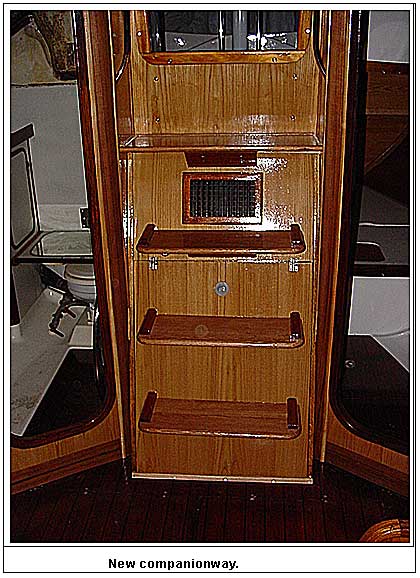 |
Now it was onto the motor which
hadn’t been run since the fire in 1999. After a few
feeble attempts to test and start the Volvo Diesel,
one which resulted in a snapped off starter gear
which in turn fell down into the motor behind the
flywheel. We then had to remove the transmission,
bell housing and flywheel in order to retrieve all
the bits and pieces of the gear. Now I know why they
say never hook up a garden hose to your fresh water
intake! The motor had flooded with water causing a
hydraulic lock in the cylinders, when we turned the
motor over the cylinders were full of water and
something had to give, thankfully it was just the
starter as it could have been much worse. You would
think that after doing all this work on the boat
that I should have realized my limitations long
before now and called a mechanic in the first place.
I was beginning to wonder if I had left the motor
too long and that this hunk of steel could be my
downfall. What if I ruined the engine? I would never
be able to buy one and install it before the
proposed launch or even afford it. I was finally
starting to get discouraged, I told my wife that if
the motor was finished so was I for this year. Was I
starting to fall into the same trap as the previous
owner and ready to give up so easily? I contacted a
friend of mine who knew a very good diesel mechanic
although he had never worked on a boat before he was
up for the challenge. The mechanic was out the next
day and after spending about 15 hrs on the metal
beast it came to life and began to roar! This time
the intake water was being sucked out of a bucket!
He reported that I had caused no damage with the
water but said that I should be glad that the motor
locked up as apparently the turbocharger was seized
and if it had started would have caused major damage
to the motor. With this news I was back on schedule
for mid May launch.
With only the radar arch and
solar panels left to install I would even have time
to paint the bottom of the boat prior to launch. Its
weird but this may be the only time in my life that
I actually looked forward to painting the bottom of
a boat but based on what I had completed in the last
6 months it seemed rather minuscule.
The boat was officially
completed three days before the scheduled launch
date of May 19, 2006 which was almost a year to the
day from the first time I had laid eyes on her on
EBay. On launch day I had several friends, family
and fellow sailors attend to watch this major
milestone and join in on the celebration, I also
think that some of them were there just to see if it
would float. Well it did float and it even looked
better in the water, that day the boat was also
christened with its new name “Steele’n TIME”,
partially based on our last name and what had to be
done in order to accomplish this project so fast.
Once rigged we spent the next few weeks conducting
shake down cruises around the bay in order to get
all the gremlins worked out. Once fully operational,
confidence in the boat grew quickly and we
eventually sailed over 1200 miles that first summer.
The following summer of 2007 we would go onto
sailing over 2200 miles on the boat, our motto has
become “let’s steal some time”.
Looking back in retrospect I do
not know if I would attempt a project of this size
again, quite frankly I am not sure if I would have
the energy or sanity to do it all over again the way
I did; patience or lack of it is truly a virtue.
Perhaps if I would have kept with the original time
frame of five years for completion the boat may have
never been completed as I am sure it would have
become more of a burden on the rest of my life and I
would have more than likely given up on it. In
addition to the energy required if it were not for a
supportive family and particularly my wife Loretta
assisting whenever she could it would not have been
possible in the first place. She also really enjoys
sailing the Great Lakes and truly shares the dream
of sailing away someday. When we look back at photos
of the condition of the boat when we first purchased
it we often think that we must have been crazy or
blind. We have never added up all the costs, this
alone would probably be another good reason never to
attempt again. We have also never added up all of
our man hours working on the boat however I do know
that there were so many that I did wear out a gas
powered generator while working on the boat so there
must be more than a few. On the positive side I know
my boat inside and out which is a definite
requirement for any Captain. I have also become much
more knowledgeable with regards to boat repair and
all systems on a boat; it seems that I have become
somewhat of a local expert, kind of a Nigel Calder
of the North (with the exception of diesel engine
repair). Even though my project is now complete my
work seems to never stop because recently two
friends of mine have bought boats that would
classify as fixer uppers. Although they are not even
close to the extremely poor condition that mine
started out in they will still require a fair amount
of work to complete, and I have a lot of favours to
repay.
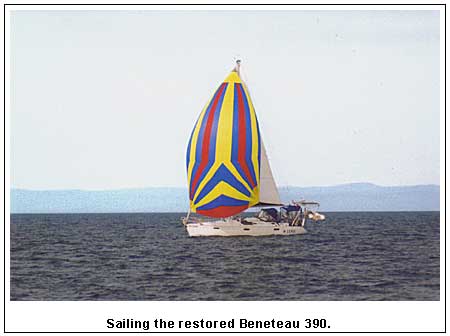 |
Ask me if I would do it again?
“Maybe?? Given the chance, but I don’t have to
because I already have the boat of my dreams, it’s a
Beneteau called Steele’n TIME”.
This is the conclusion to the article from the
April 2008 issue.
Dave Steele has been avidly
sailing the Great Lakes for over twenty years,
logging over 18,000 miles in his travels. From their
home located at Harmony Beach, Ontario, Dave along
with
his wife Margaret (a.k.a. Loretta) and their two
daughters Morgan and Mikayla spend as much time as
they can exploring the remote northern shore
of Lake Superior and Lake Huron’s North channel.
TOP
|